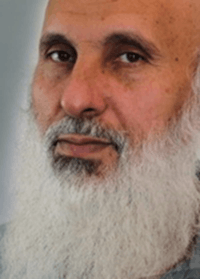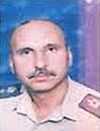Haji Bakr
| Haji Bakr | |
|---|---|
 | |
| Birth name | Samir Abd Muhammad al-Khlifawi |
| Nickname(s) |
'Knight of the Silencers'[1] 'Lord of the Shadows'[2] |
| Born |
ca. 1958-1964[2] Iraq |
| Died |
January 2014 (late fifties)[2] Syria |
| Allegiance |
|
| Service/branch |
Iraqi Army (until-2003) ISIL military (8 April 2013-January 2014) |
| Rank |
Colonel (until 2003) Commander of ISIL Military Council (April 2010-January 2014)[3] |
| Battles/wars |
1991 Iraq War |
Samir Abd Muhammad al-Khlifawi (died January 2014), better known by the nom de guerre Haji Bakr, was "the strategic head" of the rebel group "Islamic State of Iraq and the Levant" (ISIL) and previously a colonel in Saddam Hussein's intelligence services.[2] Officially he served as the head of ISIL’s military council and was leader Abu Bakr al-Baghdadi's top deputy in Syria. Papers found in his house after his death seem to prove though that he and fellow former intelligence officers were the actual leaders behind al-Baghdadi, and that Khlifawi was the one who has devised the meticulous plans for ISIL's conquests and administration of territory in Syria and Iraq.[2] He was killed in Syria by rival rebels in January 2014.[4]
Biography
During the Ba'ath regime

Prior to the 2003 invasion of Iraq and overthrow of Saddam Hussein, al-Khlifawi had been an Iraqi Army colonel who had worked on weapons development and in the intel services of Saddam's air defense corps.[5] According to Iraqi journalist Hisham al-Hashimi, whose cousin served with Khilfawi, he was stationed for a period of time at Habbaniya Air Base. Iraqi intelligence say that he joined al-Qaida in Iraq and took part in the Iraqi insurgency.[6]
After the Invasion of Iraq
Arrested by American forces, al-Khlifawi was held in detention in Camp Bucca, alongside many of the men who would form the senior leadership of ISIL, including Abu Muslim al-Turkmani, Abu Abdulrahman al-Bilawi and future leader Abu Bakr al-Baghdadi.[7][8][9]
Following his release he became a senior leader in the Islamic State of Iraq (ISI), and led the group's military council following the killing of top commanders Abu Omar al-Baghdadi and Abu Ayyub al-Masri by US Forces in 2010. Al-Khlifawi played an influential role in Abu Bakr al-Baghdadi becoming the next ISI leader, and reportedly organized an internal purge, including scores of assassinations, in order to solidify al-Baghdadi's control of the group.[5][10]
Haji Bakr was killed in early January 2014 in the northern Syrian town of Tal Rifaat by members of the Syrian Martyrs' Brigade, who did not know about his importance,[2] during the conflict between ISIL and other Syrian rebel groups.[6][10] Following Haji Bakr's death, Abu Abdulrahman al-Bilawi ascended to lead the ISIS Military Council.[11] Al-Bilawi (1971-2014) too was a former army captain, and was followed in this ISIS Military Council position by yet another former officer from Saddam's army, colonel Abu Ayman al-Iraqi (b. 1965), who is still running the operations as of April 2015.
Haji Bakr's "Master Plan" for ISIL
Khlifawi alias Haji Bakr used his training as an intelligence officer from Saddam's totalitarian state in order to plan a takeover of territory and the creation of a police state by means of intel gathering, infiltration of local power bases, dissimulation, indiscriminate terror, tactical short-term alliances with whomever, and eventually total surveillance of society and rule by fear.[2] The vehicle chosen for the takeover was a jihadi group, although Haji Bakr, or rather Colonel Samir as he was know during his Iraqi army days, was said to have been a nationalist indifferent to religion, according to Iraqi journalist Hisham al-Hashimi. Hashimi's cousin was stationed with Khilfawi at the Habbaniya Air Base. In the house he had lived in until his violent death not one copy of the Koran was found, and in the extensive writings recovered there, there is no mention of God playing any part in the creation of the so-called Islamic State. The Baath Party ideology he subscribed to is secular, what unites it with jihadism is only the common belief that the masses should be controlled by a small all-powerful elite whose legitimacy comes from its dedication to a higher principle—God to the Islamists, and the glory of Arab past and future to the Ba'athists. Khlifawi saw the religious fanaticism of the fighters he employed as a useful, but in itself insufficient tool for reaching his goals.[2][12] Khlifawi's involvement with rebel groups came in the wake of the US occupational authority in Iraq under Paul Bremer dissolving the entire Iraqi army in May 2003, which left him bitter, jobless, and in search of a means to recover control over his country.[2] Once it became clear that the former Saddamist forces didn't have the means of pushing out the invading alliance, Khlifawi became involved with the more successful head of Al-Qaeda's Iraqi branch, Abu Musab al-Zarqawi (1966–2006).[2] During the struggle Khlifawi became one of the leaders of the armed insurgency in Iraq. He managed to survive the US and Iraqi attempts at killing the top insurgents, which were otherwise quite successful, including in the case of al-Zarqawi.[2] He was arrested and held at Camp Bucca and Abu Ghraib prison, but he used the time spent there between 2006 and 2008 to forge further bonds both with former army officers of a similar background to his, and to the upcoming jihadists. There he encountered Abu Bakr al-Baghdadi, whom his small group of former intelligence officers chose in 2010 as the official leader of the "Islamic State" group: Baghdadi, as a Muslim cleric, could attract jihadi fighters which they could then lead from the background.[2] To prove that at least for some time, the actual power lay with Khlifawi and the other former intelligence officers, comes the fact that when al-Qaeda head Ayman al-Zawahiri sent an emissary to IS, he met with what he then called "these phony snakes who are betraying the real jihad", and not with Abu Bakr al-Baghdadi.[2]
Khlifawi's group took advantage of the civil war which erupted in Syria in 2011 to establish a safe base for their operations. He moved to the small Syrian town of Tell Rifaat, north of Aleppo, in late 2012. From there he helped organise the capture of parts of Syria by IS, which would in turn be used as a base for invading Iraq.[2]
The strategy he devised and documented on paper followed the principles once used by Saddam, of dividing the population and ruling it by blackmail, force, and fear. It should not be forgotten that Saddam had closely cooperated with the Soviet Union, with whom he had signed in 1972 a 15-year Treaty of Friendship and Co-operation,[13] and that the Ba'athist movement had started with having strong sympathies with the fascist movements of Europe.
Khlifawi's plans aimed at gathering information on:
- The leading families and individuals in the village or town.
- Finding out their sources of income, weaknesses and secrets which would make them open to blackmail.
- The rebel groups in the village or town, their leaders and ideological orientation.[2]
The takeover would then always follow the same pattern: IS would open bases under the guise of Islamic missionary centers or Dawahs and recruit local informers. Foreign fighters, never Iraqis who could give them away and seldom Syrians who would have local allegiances, would be secretly stationed in the targeted village or town. They would use terror attacks against local key figures, hiding behind black uniforms and masks which would also hinder their enemies from identifying them and assessing their real numbers. From their new strongholds, they would attack and take out other competing rebel groups one by one, making the other groups believe that these were small and unconnected actions, such as to avoid the building of coalitions against them. The numerous rebel brigades were focusing on the threat from Assad's regular forces, allowing this plan to indeed succeed for a while.[2] Once a territory would be captured and cleansed of rivals, the already established network of informers recruited during the first phase of infiltration would become the base of a new system of governance: a pyramid of agents working towards a group of district officers called for convenience "emirs", who would collect the intel and pass it on to the regional leadership and ensure the implementation of measures ordered by their superiors.[2] Kidnappings and murders, later executions, would make the population pliable. Once an international military and diplomatic response managed to diminish IS' flow of income from oil trade, the same repressive and well-informed security system would allow IS to tax the population, confiscate property, and suppress any attempt of rebellion, thus financing IS by squeezing the population.[2] The similarity to the Gestapo, KGB, or the East-German Stasi is clearly visible. Ironically, once pushed out of Aleppo, the IS security apparatus would share the fate of the Stasi in 1989: while it did attempt to destroy its archives of collected intelligence and operational plans by fire, its sheer quantity made this impossible, leaving many documents in the hands of IS' enemies.[2] The same happened to Khlifawi in Tell Rifaat. After a particularly brutal killing by IS of a popular rebel leader in December 2013, the the other rebel groups recognised the threat posed by IS and attacked it in a concerted operation. Khlifawi found himself in the wrong half of town, tried to avoid being captured, but was killed in an exchange of fire, and his entire cache of logistical and operational plans was discovered and retrieved. The rebels, who were keen on making public the inner workings of IS, gave exclusive access to the documents to the German magazine Der Spiegel. Similarly, the Aleppo documents were shown to Der Spiegel reporters. Thus, the precise Master Plan worked out to the last detail by Khlifawi/Haji Bakr became known to the world.[2]
References
- ↑ "Opaque structure adds to challenge of defeating Isis". Financial Times. 24 August 2014. Retrieved 23 October 2014.(subscription required)
- ↑ 2.0 2.1 2.2 2.3 2.4 2.5 2.6 2.7 2.8 2.9 2.10 2.11 2.12 2.13 2.14 2.15 2.16 2.17 2.18 2.19 Christoph Reuter (18 April 2015). "The Terror Strategist: Secret Files Reveal the Structure of Islamic State". Der Spiegel. Retrieved 18 April 2015.
- ↑ "ISIS confirms death of senior leader in Syria". Long War Journal. February 2014. Retrieved 2015.
- ↑ "Military skill and terrorist technique fuel success of ISIS". The New York Times. 27 August 2014. Retrieved 23 October 2014.
- ↑ 5.0 5.1 "The Islamic State of Iraq and Greater Syria: A Primer". The Soufan Group. 13 June 2014. Retrieved 23 October 2014.
- ↑ 6.0 6.1 "Key Al-Qaida Militant Reportedly Killed in Syria". Yahoo. 27 January 2014. Retrieved 23 October 2014.
- ↑ "Who runs the militant group Islamic State?". Reuters. Retrieved 23 October 2014.
- ↑ "Exclusive: Top ISIS leaders revealed". Al Arabiya. 13 February 2014. Retrieved 23 October 2014.
- ↑ "Deadly revenge of Saddam’s henchmen". The Times. 14 June 2014. Retrieved 23 October 2014.(subscription required)
- ↑ 10.0 10.1 "ISIS confirms death of senior leader in Syria". Long War Journal. 5 February 2014. Retrieved 23 October 2014.
- ↑ "Military Skill and Terrorist Technique Fuel Success of ISIS". New York Times. 27 August 2014. Retrieved 21 October 2014.
- ↑ Christoph Reuter (19 April 2015). "Interview with Christoph Reuter". BBC World Service: Newshour, 19 April 2015, 12:40-13:00 GMT. Archived from the original on 22 Apr 2015.
- ↑ Charles Tripp (2010). A History of Iraq. Cambridge University Press. p. 2006. ISBN 052152900X.
External links
Christoph Reuter, The Terror Strategist: Secret Files Reveal the Structure of Islamic State, Der Spiegel, 18 April 2015